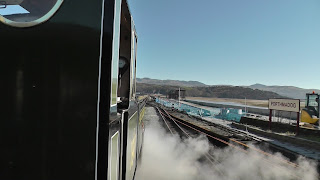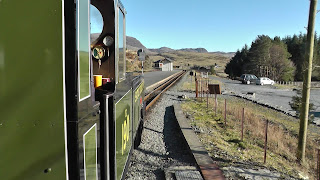 In a nutshell
In a nutshell
Gauge: 1' 11½"
Length: 13½ miles
Opened: 1836
Location:
Harbour Station
Porthmadog,
Gwynedd County
01766 516000
View Narrow Gauge Railways in a larger map
Email. enquiries@festrail.co.uk
Date of visit: 19 February 2013
Key Facts
- The railway was built originally to transport slate from the quarries and mines at Blaenau Ffestiniog to Porthmadog
- The railway was constructed on a continuous gradient of around 1:80 which enabled laden trains to travel down the line by gravity; the empties returning by horse power. Gravity trains continued to be run until 1939.
- Steam locomotives were introduced in 1863 and passenger trains run (officially) in 1865 - the first narrow gauge railway in Britain to carry passengers
- In 1869 the railway introduced articulated 'double Fairlie' locomotives
- In 1872, the first bogie passenger coaches in Britain were used on the railway
- Slate traffic on the railway ceased in 1949 until the railway was purchased by a group of enthusiasts in 1954, led by Alan Pegler.
- The railway re-opened for passenger traffic on 23 July 1955, with trains running from the Harbour Station at Porthmadog across the Cob to Boston Lodge Works
- The line was re-opened in stages to Tan--Bwlch in 1958 which acted as the line's upper terminus until 1963 when the railway was extended to Dduallt
- Because the upper part of the railway had been flooded by the construction of a reservoir at Tanygrisiau, a 'deviation' which included a spiral to gain extra height, was built (largely by volunteers). The line re-opened to Tanygrisiau in 1978.
- The final phase of re-construction to Blaenau Ffestiniog re-opened in 1983
- During the 1990s, the Festinog Railway became involved with the reconstruction of the Welsh Highland Railway which now links Porthmadog with Caernarvon allowing for continuous running over 40 miles from from Blaenau Ffestiniog to Caernarvon, making the longest operational narrow gauge railway in the UK
Route
View The Ffestiniog Railway in a larger map
My Impressions
The Ffestiniog Railway is probably the narrow gauge railway which I have visited the most over the years, ever since first discovering it (by accident) during a camping holiday with my parents in 1963. I soon after became obsessed with narrow gauge railways, joining the Festiniog Railway Society and travelling on the railway with my membership's concessionary rate many times and then again intermittently thereafter.This is my first blogged (re)visit to the railway - and no doubt will form one of many return visits. On this occasion, we started our journey at Blaenau Ffestiniog as this train was the most convenient after travelling in from Cheshire. Basing ourselves here, also enabled us to visit the Llechwedd Slate Caverns after our trip along the line.
As we had around 40 minutes to spare before the train departed, we motored a short distance down the line to watch our train pulling away from Tanygrisiau Station on its was up to Blaenau.
I was delighted to see that our locomotive was going to be Lyd, the recently constructed replica of the Lynton & Barnstaple Manning Wardle 2-6-2T, based on L&B Lew which was built in 1925.
After taking a short piece of video drove back up to Blaenau, parked and had time to take a few shots of Lyd running round the train and taking on water before boarding our train.
The building of the narrow gauge loco Lyd has been compared by some to the construction of the standard gauge locomotive, Tornado - a completely new steam locomotive built in the 21st century for commerical traffic.
As it was half-term, the train was almost full - but we managed to find a seat in the last carriage which enabled me to get some fine shots and video of the train negotiating the serpentine curves of the railway as it descended the ruling 1:80 gradient.
After skirting Llyn Ystradau reservoir at Tanygrisiau and passing the entrance and exit of the line's original Moelwyn Tunnel we traversed the 'deviation' spiral down to Dduallt Station.
As there we no passengers, the train steamed through the station and continued its descent to Tan-y-Bwlch. When I first discovered the railway in the 1960s, this was the upper terminus for the railway. Normally, Up and Down trains pass here but as we were following the winter timetable we paused for a short while before resuming our journey.
After winding our way through the woodland above the valley we shortly arrived at Penrhyndeudraeth Station. Another short stop to allow some passengers to depart and we were once more on our way.
On the platform at Minffordd were two enthusiasts of a similar age to myself. The guard sold them return tickets enabling them to travel to intermediate stations. I was put in mind of a similar negotiation which took place on this same platform 50 years previously when I was similarly issued with a hand-written ticket for a partial return journey (and somewhere in a forgotten corner, I still have that ticket).
Steaming further down the line, we passed the Boston Lodge Workshops where Lyd was conceived, born and nurtured, and then we chugged across the mile long Cob, with snow-capped Snowdon standing out in the distance.
We paused at Porthmadog Station for around 30 minutes while Lyd was fed and watered.......
..... before running around the train.
Resuming our seats we were now immediately behind the locomotive. With a throaty roar of her exhaust she pulled the heavily-laden train away and across the Cob.
After Penrhyndeudraeth we passed over Cei Mawr, the impressive stone-built embankment.
Steaming up through the woods, the engine laboured up the rising incline before rounding Whistling Curve into Tan-y-Bwlch Station where Lyd took on water once more.
As we approached Garnedd Tunnel I was reminded (almost painfully for my camera) of the very tight loading gauge on the Ffestiniog Railway which led to the butchery of the Welsh Highland Railway locomotive Russell in early days when WHR locos ran for a while on FR metals.
After passing up the spiral at Dduallt, negotiating the new Moelwyn Tunnel and running beside Llyn Ystradau, we steamed into Tanygrisiau Station for a short pause.
In no time at all we were once more in Blaenau Ffestiniog where there was time for a few more snaps of our magnificent locomotive before we left the station to pay a visit to the Lechwedd Slate Caverns.
As indicated above, this will not be my only visit to the railway. I intend to re-visit during one of the railway's festival weekends and take some lineside shots. This railway will always hold a special fascination for me and I never cease to be impressed by its history, its tenacity and its general ambience. For some, the railway has become overly commercialised, but it seems to me that beneath the veneer, the values and soul of one of the leading pioneering volunteer-run narrow gauge railways is still very much in evidence.















No comments:
Post a Comment